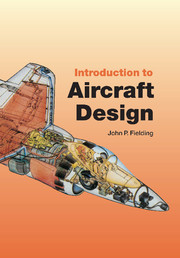Book contents
- Frontmatter
- Contents
- Preface
- Acknowledgements
- 1 Introduction
- 2 Why should we design a new aircraft?
- 3 Why is it that shape? – Civil aircraft
- 4 Why is it that shape? – Other types
- 5 What's under the skin? – Structure and propulsion
- 6 What's under the skin? – Airframe systems
- 7 What's under the skin? – Avionics, flight control and weapon systems
- 8 Why do aircraft cost so much?
- 9 What help can I get? – Bibliography and computer-aided design
- 10 The shape of things to come – Should the project continue?
- 11 What can go wrong? – Some lessons from past aircraft projects, and a glimpse into the future
- Appendix A Useful aircraft design data
- Appendix B A–90 parametric study. Example – the A-90 500-seat airliner
- Appendix C The prediction of aircraft reliability and maintainability targets
- References
- Index
5 - What's under the skin? – Structure and propulsion
- Frontmatter
- Contents
- Preface
- Acknowledgements
- 1 Introduction
- 2 Why should we design a new aircraft?
- 3 Why is it that shape? – Civil aircraft
- 4 Why is it that shape? – Other types
- 5 What's under the skin? – Structure and propulsion
- 6 What's under the skin? – Airframe systems
- 7 What's under the skin? – Avionics, flight control and weapon systems
- 8 Why do aircraft cost so much?
- 9 What help can I get? – Bibliography and computer-aided design
- 10 The shape of things to come – Should the project continue?
- 11 What can go wrong? – Some lessons from past aircraft projects, and a glimpse into the future
- Appendix A Useful aircraft design data
- Appendix B A–90 parametric study. Example – the A-90 500-seat airliner
- Appendix C The prediction of aircraft reliability and maintainability targets
- References
- Index
Summary
General
Having looked at the reasons for designing a new aircraft, its requirements, and the reasons for its external shape, it is now the time to look at the interior. One might use the analogy of a human body to see that for successful operation it requires a skeleton, muscles, digestive system, sensors and a control system. These all work together efficiently even when they have different functions. The aircraft designer must produce a similar harmony within the aircraft interior. Each system is important, but each may have conflicting requirements. A good designer must weigh up the conflicts, use relevant analyses and synthesize the aircraft into an efficient whole. It is a truism that the outside of the aircraft has to be bigger than the space required inside the aircraft. It is often necessary to modify the external shape to accommodate the interior, with consequent aerodynamic changes.
To return to the body analogy, this chapter will describe the aircraft's skeleton, muscles, sensors, etc. in terms of structure and propulsion. Fuel, flying controls, avionics, furnishing and weapon systems will be described in Chapters 6 and 7.
The structure
An aircraft structure should be designed to meet a number of conflicting requirements which include:-
(i) Low weight.
(ii) Acceptable material and manufacturing costs.
(iii) Adequate strength to meet the maximum expected loads, with a suitable safety factor.
(iv) Adequate stiffness so that distortions are kept within acceptable limits.
[…]
- Type
- Chapter
- Information
- Introduction to Aircraft Design , pp. 55 - 72Publisher: Cambridge University PressPrint publication year: 1999

